Laying a new lawn with turf.
Laying a new lawn is hard work and more expensive than sowing seed, but it gives an instant, lush looking lawn as soon as you've finished.
Preparation
There's a reason you are laying a new lawn. If it's poor drainage, an uneven surface or the lawn has become compacted, it's best to sort these problems out first.
- Drainage: If you have clay soil and rainwater remains on the lowest area of the lawn after a downpour, dig a soakaway (depending on the size of the lawn) of at least 60cm (24 in) wide by 90cm (36 in) deep. Back fill with 60cm of small rubble/stones, 15cm (6 in) of grit/small stones followed by a topping of 15cm of topsoil.
- Leveling: One of the most important tasks is to get the plot flat, if you have bumps and hollows in the ground work you'll end up scalping the raised areas and leaving long grass in the depressions when mowing .
- Compaction: With regular use, the soil under the lawn can become compacted, especially on routes between the house, compost heap, greenhouse and shed. Compacted soil will restrict the root growth of existing grass and stop new grass roots from growing.
Personally, on areas that are compacted, before thinking about returfing, I'd first try and solve the problem by aerating the affected area with a garden fork, pushing it half way into the ground, then gently moving the handle forwards and back, repeating this 6 inches apart over the whole area. This will allow air and moisture to get down to the roots. Then gently raking the area with a metal tined rake, then over-seeding with grass seed specifically bred for heavy traffic areas. Before sowing any new seed, I'd perhaps consider if the worn areas are a route between two points, whether to buy or cast some concrete stepping stones to take some of the future wear and tear.
But if you do want to relay turf and there isn't any grass left in these areas, remove any remaining patches grass/turf from a 2ft(60cm) wide path (turf comes in 2ft wide rolls), then dig with a garden fork, down to about 9 inches, breaking up any large clumps of soil, before relaying turf as discussed below.
Buying turf
 If you are buying turf from a garden centre, phone them beforehand, as well as asking whether they have any in stock, ask them when they have their deliveries. Most garden centres only receive one or two deliveries per week, if you buy turf that has sat at the garden centre for 3-4 days it will have started to yellow and die. Always examine the roll of turf before buying - unroll a couple of turves, check that the grass is still lush and green, hold the end of a turf with both hands and give it a gentle shake, if the grass is yellowing or it falls apart don't buy it.
If you are buying turf from a garden centre, phone them beforehand, as well as asking whether they have any in stock, ask them when they have their deliveries. Most garden centres only receive one or two deliveries per week, if you buy turf that has sat at the garden centre for 3-4 days it will have started to yellow and die. Always examine the roll of turf before buying - unroll a couple of turves, check that the grass is still lush and green, hold the end of a turf with both hands and give it a gentle shake, if the grass is yellowing or it falls apart don't buy it.
If you have an area over 6 square metres, to save the rear axle of your car, I'd suggest that you get it delivered.
When getting a delivery, check the turf before it is off-loaded, there are some unscrupulous people out there that will sell weed ridden, dead and dry turves to the unsuspecting. Personally I've always used Rolawn (a local supplier should be in the Yellow Pages), I've never had any problem with them, the grass is always lush and weed free and the turves are easy to lay. Expect to pay around £7 per m2.
How much turf to buy?
Measure the width and length of where you want your new lawn, multiple these together to give the area. Turf is normally sold in 1 square metre rolls (although check with your supplier so you don't under order), if you've measured your area in centimeters you'll have to convert it to square metres before ordering (100cm = 1m, 10,000cm2 = 1m2). Add an additional 5% extra for wastage.
An example project:
 |
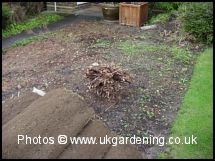 |
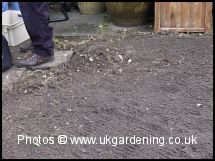 |
||
Here we have a relatively small front garden that needs turfing. We cleared the area, removing some trees and shrubs. If you have existing grass, lift this and stack upside down in an unused area of the garden, after a year this will turn into a lovely loam that can be used in the garden. |
This garden slopes from a high point closest to the camera to a low point furthest from the camera. The low point could be a water logging concern but this soil is free-draining, sandy soil, so we don't have to worry too much about drainage. If you have a clay soil, see the drainage section above. |
We've removed the roots and weeds and dug over the topsoil to approximately 15cm (6 in), flattening out any large lumps with the back of the fork. |
||
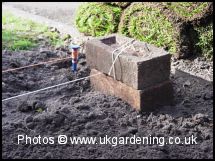 |
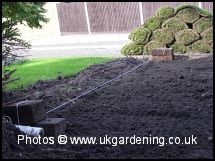 |
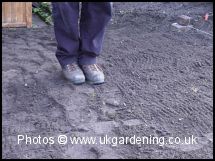 |
||
We now need to work out the levels. With this garden there isn't an awful lot we can do about the gradient. It would be great to have a perfectly level, flat lawn, but the pavement to the front, path to one side and higher lawn next door prevent this. Wrap one end of a line of string around a brick and sit it on another, do the same at the other end of the plot. Do the same in the other direction. If you want a level lawn hold a spirit level up against your string line and raise one end of the line accordingly. Note: When grading the soil make sure that the height of the lawn is going to be slightly higher than any path around it, else you'll be catching the blade of your lawnmower when you come to mowing. |
If the site is larger than this one, knock in stakes at 2m (6.5 ft.) intervals, in both directions, leveling them or make sure they follow your gradient. If you have deep topsoil you can use a rake to move the soil from the high points to the low points, if you don't fill the hollows with additional topsoil. What you are trying to achieve is a flat surface, any humps and hollows will detract from the finished lawn. |
Now that we've got the soil to a nice tilth, we are going to tread all over it!. Taking little steps, make sure that you tread over the entire site, removing any large stones. This ensures that there aren't any voids in the topsoil. |
||
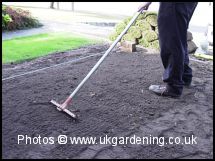 |
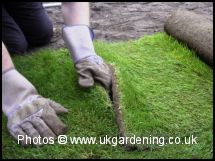 |
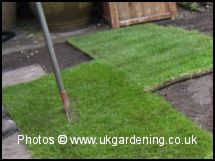 |
||
After firming the soil, gently rake it over, just lifting out the footprints. |
Starting in one corner lay the first turf. If you are laying next to a path or driveway start here and use this as a datum, otherwise use your string line as a guide to keep you straight. When you place the second and subsequent turves, lift both ends and tuck them in together, this helps prevent gaps appearing if the lawn dries out too much. |
Once the first row is down, tamp the surface gently with the tines of a rake, you are just trying to remove any air gaps under the turf and not trying to hammer it into the soil. With the second row, stagger the turf so that no joins meet with the joins of the previous row. Continue to lay the turves, if you need to tread on the grass, use scaffolding boards or planking. |
||
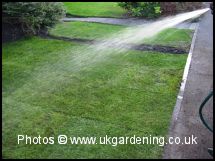 |
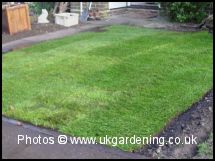 |
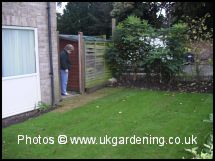 |
||
When completed, make sure that you water the grass well. Keep watering every day for a week, if it hasn't rained. Followed by every other day for a further week. Try to stay off the new lawn for a few days. Start cutting the grass when it needs it (normally after a couple of weeks). |
The finished article. A great looking lush lawn, created in a day. |
Another lawn that I created. |
||
Other gardening how to pages:
- Growing plants from seed
- Create a hanging basket
- Laying a new lawn
- Making leaf mould
- Chitting and growing potatoes
- Care of Hippeastrum/Amaryllis after flowering
- Cleaning patios, paths and decking
- Removing large branches
- Creating a compost heap
- Moving a tree or large shrub
- Fencing and trellis
- Building a rockery
- Planting a winter basket
- Building a pond
- Make a large spirit level
